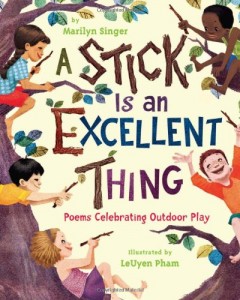This is a children’s picture book structure break down for This Orq. (He Cave Boy.) by David Elliott and Lori Nichols. This breakdown will contain spoilers.…
Add a CommentViewing: Blog Posts Tagged with: David Elliott, Most Recent at Top [Help]
Results 1 - 5 of 5
Blog: RabbleBoy (Login to Add to MyJacketFlap)
JacketFlap tags: Book Reviews, Children's Picture Books, children's picture book, David Elliott, Lori Nichols, animals picture book, cave boy picture book, cave man picture book, dorq, orq, Add a tag
Blog: A Year of Reading (Login to Add to MyJacketFlap)
JacketFlap tags: Poetry Friday, tigers, David Elliott, Add a tag
THE TYGER
by William Blake
Tyger! Tyger! burning bright
In the forests of the night,
What immortal hand or eye
Could frame thy fearful symmetry?
In what distant deeps or skies
Burnt the fire of thine eyes?
On what wings dare he aspire?
What the hand dare seize the fire?
And what shoulder, and what art,
Could twist the sinews of thy heart?
And when thy heart began to beat,
What dread hand? and what dread feet?
What the hammer? what the chain?
In what furnace was thy brain?
What the anvil? what dread grasp
Dare its deadly terrors clasp?
When the stars threw down their spears,
And watered heaven with their tears,
Did he smile his work to see?
Did he who made the Lamb make thee?
Tyger! Tyger! burning bright
In the forests of the night,
What immortal hand or eye,
Dare frame thy fearful symmetry?
Blog: The Children's Book Review (Login to Add to MyJacketFlap)
JacketFlap tags: Book Lists, featured, Stacey Schuett, Gail Carson Levine, Shel Silverstein, National Poetry Month, Alan Katz, Holly Meade, Leuyen Pham, Mary Ann Hoberman, Meilo So, Kate Coombs, Danielle Wright, Matthew Cordell, David Elliott, Jackie Urbanovic, Marilyn Singer, Michael Emberley, Amy E. Sklansky, Edward Koren, Poetry & Rhyme, Helen Acraman, Ages 0-3, Ages 4-8, Ages 9-12, Jack Prelutsky, Picture Books, Add a tag
By Nicki Richesin, The Children’s Book Review
Published: April 25, 2012
Beautiful Dreamers
In celebration of National Poetry Month, we’ve hand-picked ten many-splendored new books. Children are born loving poetry from the moment they form their first babbling words to when they begin to tackle more complex rhythms and tongue twisters. As they acquire language and enjoy how it rolls off their tongues, they also gain an appreciation for the beauty of creative expression. Nothing quite tops that moment when they learn to recite their first nursery rhyme. So leave a poem in your child’s pocket and help him discover the appeal of modern poetry.
Every Thing On It
If you’re like most of us, you may have grown up with Where the Sidewalk Ends, A Light in the Attic, or The Giving Tree on your childhood bookshelf. Master wordsmith and doodler Shel Silverstein invented laugh-out-loud silly rhymes for us to endlessly ponder. Every Thing On It has been posthumously published as a new collection of his irreverent poems and characters drawn with his trademark squiggly offhand style. It’s a great joy to share his nonsense poems with a new generation to puzzle over and love for years to come.
Ages 8-11 | Publisher: HarperCollins | September 20, 2011
 A Stick Is An Excellent Thing
A Stick Is An Excellent Thing
By Marilyn Singer; Illustrated by LeUyen Pham
What a winning combination Pham’s playful illustrations and Singer’s amusing verse make in this lovely poetry collection. Bouncing rhyme and pictures of active children at play ensure even the most poetry-adverse child will warm to its magical delights. As Singer’s light-handed verse concludes, “A stick is an excellent thing if you find the perfect one.” We’ve certainly found the perfect book of poetry in this one. For more on LeUyen Pham, check out our interview with her.
Ages 5-8 | Publisher: Houghton Mifflin Harcourt | February 28, 2012
 Water Sings Blue
Water Sings Blue
By Kate Coombs; Illustrated by Meilo So
In her first book of poetry, Kate Coombs takes us on a voyage under the sea.
Add a CommentBlog: I.N.K.: Interesting Non fiction for Kids (Login to Add to MyJacketFlap)
JacketFlap tags: David Elliott, author visits, school visits, Susan E. Goodman, Add a tag
On January 12th, Susan Kuklin wrote a great blog about the author visit she did with three fellow writers in New Orleans. I recently did a much more local school visit with just one other author, my Lesley University colleague David Elliott. Afterward we received a wonderful note from Mayre Plunkett, the PTO parent who shepherded us through. It was a great reminder that there are many reasons authors should be visiting schools besides the ones that obviously come to mind. Just take a look:
Dear Susan & David,
Just wanted to say THANK YOU so much for coming to the Ohrenberger last Friday; students & teachers alike are still all abuzz.
A bit of feedback to share:
The music teacher came up to me yesterday and told me he was so inspired that he is going back to work on his book.
A kindergartner leaped at the chance to go to a Fancy Nancy event so she could meet another 'live author.'
A fifth grader went home and started talking about character development with his parents.
All of the first & second graders illustrated their group poem.
I could go on and on. Please know that you both deeply impacted the school and we will always be grateful.
Mayre
ps. One more to add, Nick (SG: Mayre’s son) was putting On This Spot (SG: my book that I read to the kindergarteners) to music Saturday night—at the top of his lungs!
These are all great reasons, aren't there? And hard to have predicted beforehand.
Blog: I.N.K.: Interesting Non fiction for Kids (Login to Add to MyJacketFlap)
JacketFlap tags: book recommendations, Susan E. Goodman, David Elliott, libraries, Add a tag
It seems like several of the I.N.K. bloggers have been hitting the road lately, and I’m one of them. I’m in Mexico so my friend and colleague David Elliott has agreed to take my place today. David considers himself a children’s fiction writer and I suppose that’s true. He’s too gracious to say it, but the novel he mentions below, Jeremy Cabbage and the Living Museum of Human Oddballs and Quadruped Delights, has been optioned by Fox 2000. But some of David’s picture books are poetry about animals and could easily be classified as nonfiction. On The Farm, for example, received many starred reviews because David used facts and great eloquence to distill common farm animals to their very essence. If you want to know more about him, check out http://www.davidelliottbooks.com/index.html.
Here’s David:
I grew up in the 50s in a Midwestern farm town, the kind of place where on Saturdays the farmers sat on the courthouse lawn while their wives did the weekly shopping. It was a town very much like thousands of others scattered throughout the no-nonsense states of Ohio, Indiana and Michigan. But it did have three distinctions. 1) It was the home of the Mills Brothers. 2) It was the site of the first concrete street in the United States. And since my friend Susan Goodman has taught me that any quirky fact can become a compelling story in the hands of the right person, I’ll give you the name: Court Street. 3) It had a Carnegie Free Library.
This library sat on a rise, directly across from the Eicholtz Funeral Home, and kitty-corner to the Lutheran Church. It was the grandest building in town, a neo-gothic affair with a sturdy column on either side of its welcoming entrance. But I didn’t need encouragement, architectural or otherwise. To a working class kid like myself, anything free was good. I spent a lot of time there.
I still remember the way that library smelled when you crossed over its oak threshold, a peculiar mixture of floor-polish, new books, and vomit (a lot of kids used that library) all permeated with the florid scent of the librarian’s eau de toilette. But it’s the library’s floor plan that I’ve been thinking about. As you entered the foyer, wide and high-ceilinged, the kids’ books were tidily shelved in low cases in a room to the right. To the left, directly opposing was the reference room, with its maps, and its histories, and its encyclopedias. Even now, that room gives me a bad feeling. There was only one reason to go in there: Homework.
Recently, I have had the good fortune to visit another Carnegie Free Library, here in New Hampshire, and to my surprise the floor plan was exactly the same. The reference room was on the left, the kids’ books on the right.
This arrangement set me thinking because it seemed to reinforce the odd idea that the world of the fiction was naturally distinct from the world of facts. (No doubt, there were some nonfiction books in that kids’ room, but not many, and I certainly didn’t know where they were shelved.) I understand the comfort of this kind of polarity. It’s clean, and we all know what cleanliness is next to. But I wonder if this kind of thinking sacrifices what is true for what is easy.
I’m now not so sure that this border between fact and fiction exists at all, or at the very least, if it isn’t more liquid than we allow it to be. After all, every scientific advancement, every cultural artifact, every technological gizmo first started in someone’s imagination. And our imaginations would be useless without some hard nouns, some facts to pin them onto.
As a fiction writer, I couldn’t get anywhere without the nonfiction world. This is also true when I’m working on a picture book. Recently, in doing some research for a book of verses about wild animals, I learned that it’s the lion’s ability to roar, along with the tiger’s, the leopard’s and the jaguar’s, that makes them Great Cats. I also discovered that lions rarely roar in the daytime. Who knew? But these two pieces of non-fiction became the basis of the verse that will open the book. And the reverse is true as well. In looking at some of the fabulous nonfiction books currently being published, it’s clear that without the engagement of their authors’ imaginations, the books would not be books at all, but simply glorified lists, the kind of thing that as a gift felt the equivalent of getting a toothbrush in your stocking at Christmas.
In my most recent novel, the protagonist is a street kid who has taken up residence in an abandoned library. In one scene, we see him in the library’s fiction section, reading to find some comfort from the sad truth of his life. I wonder now why I didn’t let him find the nonfiction shelves. Surely, there is just as much comfort to be found in learning about the lives of children, say, from Pago-Pago, the peculiar habits of the naked mole rat, the downfall of history’s biggest bullies.
Or maybe, I should have revolutionized those shelves altogether and put The Truth About Poop next to Octavian Nothing, Rocks in His Head next to From the Mixed Up Files of Mrs. Basil E. Frankweiler, thereby destroying a dichotomy that may not be as clear as we sometimes think.





I have always loved that Blake poem too. What wonderful students you have!
Every time I read something about your classroom, I wish I lived in Ohio and could come and see your brilliance personally. You are amazing! This story gives me goosebumps!
Oh my gosh, Mary Lee - your recounting of your student's comments give ME chills! That's a lot of chills for an old poem. (And we have to throw in Carol's goosebumps, too.) You have cultivated room for wonder in your classroom, and that's magical. I love IN THE WILD - a gorgeous book. [Blake's tyger has followed me around since the first time I met it, too, many moons ago. I missed the wild video at Tabatha's; thanks for sharing here.]
That story gave me chills, too. It's so magical when kids connect with poems viscerally.
Hi ML! Great pair of poems, and thanks for sharing the classroom story. -Ed
Save the tigers!
I posted lyrics from Matt Nathanson's song All We Are today at Bildungsroman:
http://slayground.livejournal.com/699647.html
http://slayground.livejournal.com/699647.html
Wonderful post, Mary Lee! Hadn't seen Elliot's poem's before so that was a real treat -- Blake's poem is still magical. Didn't encounter it until college though. I envy your 4th graders!
Great story, Mary Lee. We really don't know what someone is taking in, maybe even what they are saving for a rainy day.
How wonderful your fourth-graders are already haunted by poetry. May it never end.
A few years ago, were you at the Library of Congress with the kidlit bloggers when they brought out a Tyger manuscript for us to ogle?
What a story for your journals Mary Lee, to capture for sharing again & again with other students. Very well done!
Your influence extends well beyond your knowing. Good teachers are like that. Thank you for all you do with those young ones in your classroom.
It's that last quarter, they seem to arrive somehow .... Book clubs, for instance, have become so fascinating to listen into. It always seems so unfair that this quarter seems to fly by the fastest!
I have read the Blake poem a number of times of the years and still don't have a clue what it is about! LOL I like Elliott's poem. Nice comparison.
I am not even sure where to start...awesome video, love your chilling moment with A (that is the best), both poems are so thought provoking, I love the Elliott poem "they are wild and distant, the tiger and the star. Love it all!
My daughter is in fourth grade and she is enjoying poetry greatly. She is familiar with this Blake poem primarily because we watch the TV series 'The Mentalist' (hehehehe, i know i know) and this poem has always been used in that TV show. One of my favorite poem by William Blake. Thank you for sharing this. :)
It's so wonderful seeing students respond to words. I love it. I can live for days on one moment like that. Thanks for sharing it!